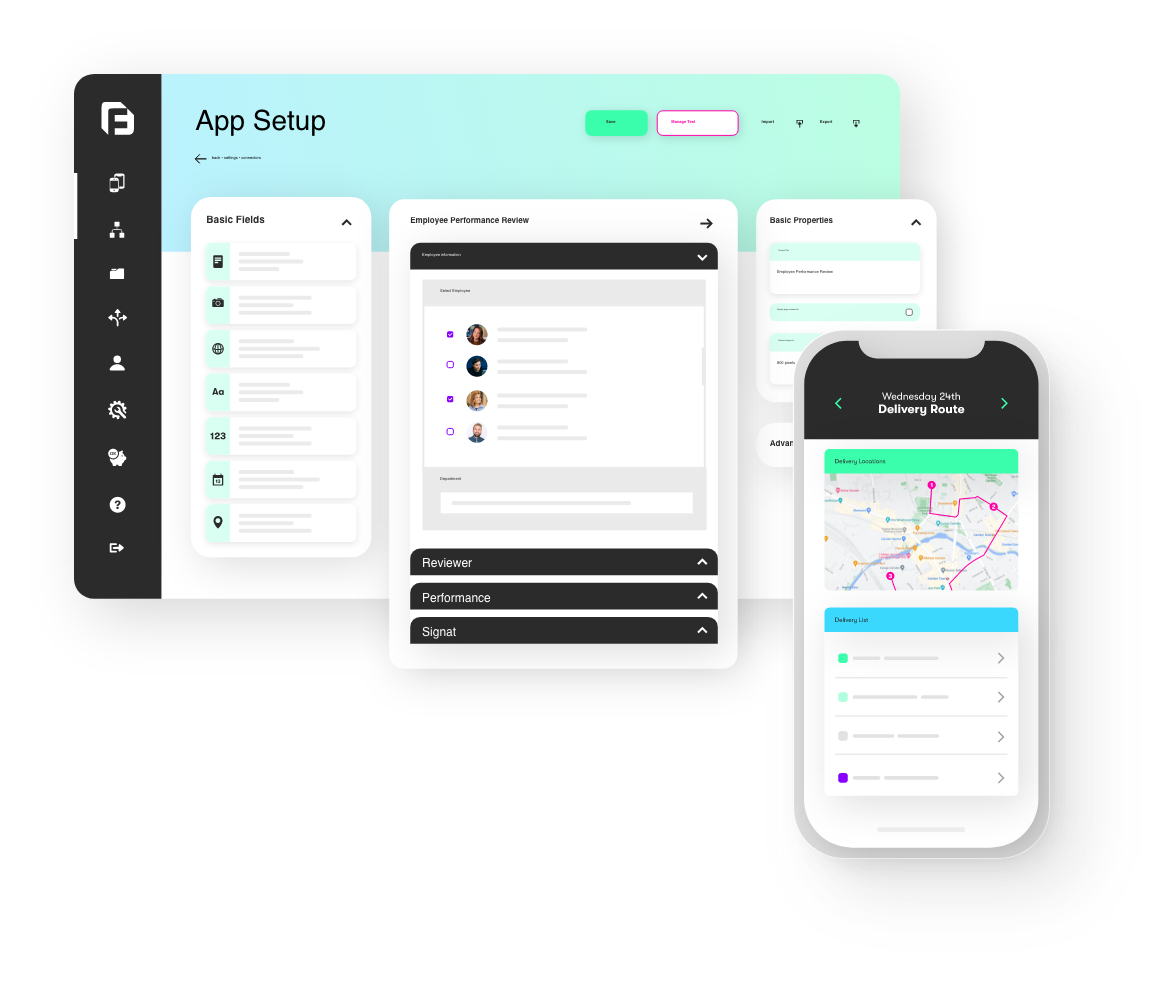We Show You 5 Reasons Why REST API Is Needed, Especially In Mobile Forms
If you’ve landed on our page, you’re probably wondering why REST API is needed and how you can use it in conjunction with your mobile forms and your own external systems.
We get it – there are plenty of options out there including SOAP. So why should you care and what are the benefits of REST API, or Restful API, as it’s otherwise known. The best way of understanding why you need REST API is to understand the benefits.
But first a quick lesson:
So, what is REST API (RESTful API)?
In short, a REST API allows you to use HTTP requests to access and use data. You can use that DATA to GET, PUT, POST, PATCH and DELETE data types which means you can create, read, update and delete data from external resources such as HubSpot, What3words and more.
That’s just scratching the surface. Our rest API allows you to bring data from your existing systems into forms2, and also pass data captured from your mobile forms and apps back into your existing systems.
5 Benefits Of REST API in Mobile Forms
Of course, there are more than 5 benefits and reasons why you need REST API when building your workflows, apps and interacting with your own technical stack. For now, we’ll keep it to 5 key reasons why you need REST API. We’ll also discuss how it helps you increase workflow as part of forms2.
1. Rest Uses HTTP Calls Making It Easy To Understand
REST works with HTTP – in fact, it was actually a major influence behind HTTP! This means the REST API uses verbs most of us are familiar with – so it’s easier to understand and interact with on all levels, both developer and user.
- Our REST API uses five basic HTTP requests:
- POST – create
- PUT – edit
- GET – retrieve
- PATCH – modify
- DELETE – delete
How does this improve your workflow and mobile form?
The fact that REST API uses these verbs means you can not only understand commands easier, but you can implement, connect and interact with external information systems whenever you like.
2. Issue REST Requests in JSON or XML
When it comes to REST vs SOAP, users are favouring REST due to the fact you are not limited to using XML. One of the key benefits of REST is the fact you can connect to pretty much any API and can return JSON, YAML, HTML and XML.
How does this improve your workflow and mobile form?
This means your REST API, which is integrated into your forms2 account, is fast, less fuss and compatible across almost any external information system. Information is there as soon as you need it as JSON is far more compact when it comes to code – a key reason why REST API is needed in the mobile form world.
3. Rest API is Stateless and Scalable
You might be wondering: is REST API Stateless? Yes, REST utilises a stateless client/server protocol. The user interface (UI) and the data storage is separated from the server which means memory is only occupied when you’re making a request. As soon as that request has been processed the memory is freed up again.
How does this improve your workflow and mobile forms?
So how does this improve your forms2 experience? Well, your apps won’t slow down, no matter how many REST calls you make. When using REST connectors on your forms to pass captured data back to your systems, updates happen almost instantly meaning your systems will be up to date once your users complete and submit a form. When using REST connectors on your Data Sources, your existing systems can check every 15 minutes for any new data to be pulled in, keeping your mobile users up to date with the latest data from your databases, CRM’s etc.
This also means any developments across your custom forms2 system will not interrupt existing workflows.
Because REST API is stateless, your workflow is also scalable – there are no limitations on the information you can pull in or push out to staff and stakeholders or the number of systems you want to integrate with.
4. REST Is A Flexible Solution
One of the key reasons REST API is needed is its flexibility. The Data you need is never tied to any particular data type such as JSON, XML etc.
You can effectively carry out changes to your database and perform seamless migrations from one server to another and you can send and receive data in a wide variety of different formats.
How does this improve your workflow and mobile form?
You could be connecting to multiple external systems at any one time, receiving critical, potentially lifesaving information. These external systems could be using XML and another using JSON. Whereas some solutions may not allow the communication between the two, a REST API makes sure you can use both.
This leads us to our next point.
5. You Can Push/Pull Data From External Systems In Real Time
Working with a range of different data sets across different platforms can be awkward at best, and extremely unsafe at its worst.
Representational State Transfer, or Rest API for short, used in conjunction with a REST API connector ensures accurate data representation and integration at scale. It allows you to update and retrieve from all specified data sets including the likes of Insightly, Jama, and what3words, in real-time. You can send jobs, set automatic updates and communicate exactly WHAT you need, WHEN you need it. Automation is a key feature.
How does REST API improve your workflow and mobile forms?
Let’s use real-world examples of how a REST API in conjunction with our mobile form could potentially save lives.

Scenario #1 – Instant Workforce & Job Management
Let’s say you own or manage a welding company and you have workforce on the ground during a shutdown. You can have all of your workers’ details in your CRM. The API is used to pull those details into a forms2 data source.
This data source is then used within any forms or apps you wish to build for your field teams – these are data source REST connectors.
Now, let’s say you have a welder on site. We’ll call him Scott.
Scott’s engineer in charge (for example) needs to send out jobs. The engineer can select Scott’s name from a list, and have several subsequent fields populated, like location, current job and more, instantly.
Any of those details could then be updated by the engineer, via the mobile form. This could include new jobs, installations or vital information like dangers or safety info. The engineer then completes the form and uploads it back to the forms2 platform.
There would be another REST connector configured to send any data captured by the engineer back into the CRM (via form REST connectors).
Scott will be able to see this information instantly, before he starts his day and make accurate decisions.

Scenario #2 – When Knowing The Weather Could Save Lives
Worker safety is paramount. It’s also a major focus here at forms2.
Being able to use our REST field type within a form could actually save a life.
Our platform allows you to use a REST field type so you can tap a button in your form to retrieve real-time data from an external source.
Let’s pretend we have a crane driver. Her name is Sarah.
Sarah’s job is not only dangerous, it’s also heavily reliant on the weather. Accurate knowledge of the weather allows her to do her job properly and safely. Visual confirmation is not good enough.
Before starting work, Sarah can select a location (customer site, postcode, GPS etc) and then send the location details using the REST field to the likes of Weatherstack, and retrieve the current recorded weather conditions for her location.
She may have thought the weather was going to be clear, but upon instant inspection via her mobile form using REST API, she is alerted that a thunderstorm is on its way, thus making the job unsafe.
She has just averted disaster at the touch of a button.
This use of REST API makes it useful for obtaining accurate weather data that may be needed for reporting or insurance purposes, too.
Your workforce could be working at height maintaining a cell tower, unaware a rainstorm is headed towards their location. This accurate weather data fed into the forms2 apps via the REST API functionality means that, although adverse weather may not be expected, you’ll know if it’s about to hit.
The fact you have access to key information instantly is a key benefit of REST API.
REST API, when used with our system, allows for wider control over important communication and effective management of the team by pulling together all the information into one location – in the palm of your hand!
This partnership between forms2 mobile forms and a REST API functionality allows you to make safe, accurate decisions and alert the right people – this is easily one of the key
reasons REST API is needed.
So, How Do We Use REST API Here At forms2?
Well, we’re glad you asked! Here are 3 of the key features and benefits that REST provides within our app.
1. Connect To Any REST API Exposed Database
Our REST connector provides users with the ability to connect to almost any external service that exposes a REST API. View all integrations.
2. Fully Customisable Mobile Forms
You can even customise the request body which allows you to paste your own custom XML or JSON data payloads – you can find out more and see a REST API post JSON example on our blog.
3. Pull Your Data Into One Place
Our REST API connector allows you to pull your data into our mobile platform and send it back into your systems – like a messenger on your phone acting in real-time.
Our interface lets you seamlessly integrate our mobile forms builder into your workflow, whether you’re using Amazon Web Service, SQL Server, Salesforce and more. View the full range of platforms you can integrate into your bespoke mobile form experience here.
Improve your workflow in 1 hour.
If you want to remove the cost and delay of data publication, reduce distribution costs and time while improving safety, workflow and KPI’s, speak to our friendly team today. We can help you create dynamic, bespoke mobile forms and apps to help your business reach its goals.
Each form is tailored completely to your needs. We are not an “off the shelf” service, but a bespoke mobile solutions service for all industries including Oil & Gas, Manufacturing and more.
Speak to a platform specialist at forms2 and build your own scalable Android, iOS and Windows business apps and mobile forms in hours, not months.


